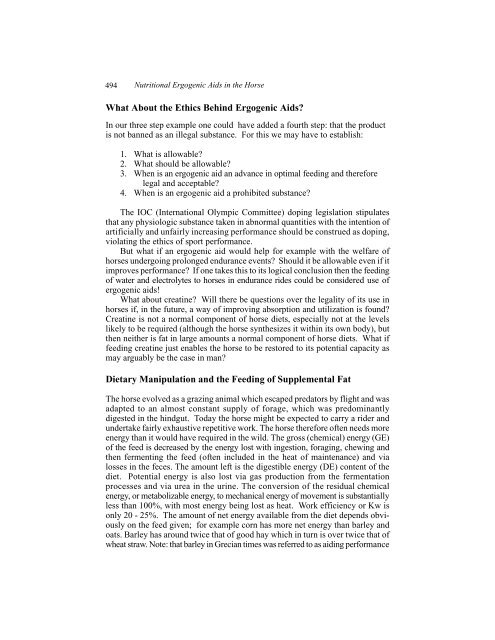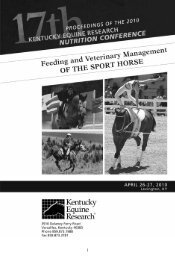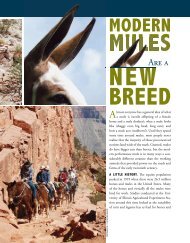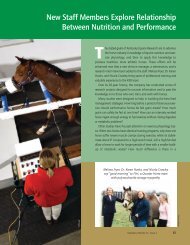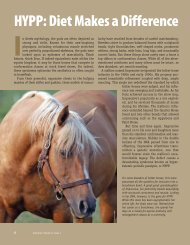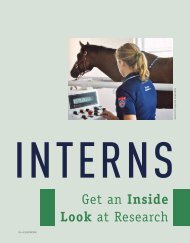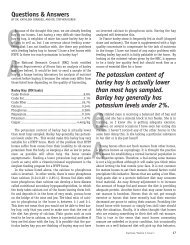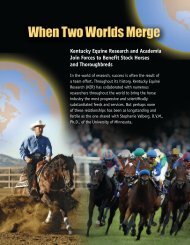Nutritional Ergogenic Aids in the Horse - Kentucky Equine Research
Nutritional Ergogenic Aids in the Horse - Kentucky Equine Research
Nutritional Ergogenic Aids in the Horse - Kentucky Equine Research
- No tags were found...
Create successful ePaper yourself
Turn your PDF publications into a flip-book with our unique Google optimized e-Paper software.
494 <strong>Nutritional</strong> <strong>Ergogenic</strong> <strong>Aids</strong> <strong>in</strong> <strong>the</strong> <strong>Horse</strong>What About <strong>the</strong> Ethics Beh<strong>in</strong>d <strong>Ergogenic</strong> <strong>Aids</strong>?In our three step example one could have added a fourth step: that <strong>the</strong> productis not banned as an illegal substance. For this we may have to establish:1. What is allowable?2. What should be allowable?3. When is an ergogenic aid an advance <strong>in</strong> optimal feed<strong>in</strong>g and <strong>the</strong>reforelegal and acceptable?4. When is an ergogenic aid a prohibited substance?The IOC (International Olympic Committee) dop<strong>in</strong>g legislation stipulatesthat any physiologic substance taken <strong>in</strong> abnormal quantities with <strong>the</strong> <strong>in</strong>tention ofartificially and unfairly <strong>in</strong>creas<strong>in</strong>g performance should be construed as dop<strong>in</strong>g,violat<strong>in</strong>g <strong>the</strong> ethics of sport performance.But what if an ergogenic aid would help for example with <strong>the</strong> welfare ofhorses undergo<strong>in</strong>g prolonged endurance events? Should it be allowable even if itimproves performance? If one takes this to its logical conclusion <strong>the</strong>n <strong>the</strong> feed<strong>in</strong>gof water and electrolytes to horses <strong>in</strong> endurance rides could be considered use ofergogenic aids!What about creat<strong>in</strong>e? Will <strong>the</strong>re be questions over <strong>the</strong> legality of its use <strong>in</strong>horses if, <strong>in</strong> <strong>the</strong> future, a way of improv<strong>in</strong>g absorption and utilization is found?Creat<strong>in</strong>e is not a normal component of horse diets, especially not at <strong>the</strong> levelslikely to be required (although <strong>the</strong> horse syn<strong>the</strong>sizes it with<strong>in</strong> its own body), but<strong>the</strong>n nei<strong>the</strong>r is fat <strong>in</strong> large amounts a normal component of horse diets. What iffeed<strong>in</strong>g creat<strong>in</strong>e just enables <strong>the</strong> horse to be restored to its potential capacity asmay arguably be <strong>the</strong> case <strong>in</strong> man?Dietary Manipulation and <strong>the</strong> Feed<strong>in</strong>g of Supplemental FatThe horse evolved as a graz<strong>in</strong>g animal which escaped predators by flight and wasadapted to an almost constant supply of forage, which was predom<strong>in</strong>antlydigested <strong>in</strong> <strong>the</strong> h<strong>in</strong>dgut. Today <strong>the</strong> horse might be expected to carry a rider andundertake fairly exhaustive repetitive work. The horse <strong>the</strong>refore often needs moreenergy than it would have required <strong>in</strong> <strong>the</strong> wild. The gross (chemical) energy (GE)of <strong>the</strong> feed is decreased by <strong>the</strong> energy lost with <strong>in</strong>gestion, forag<strong>in</strong>g, chew<strong>in</strong>g and<strong>the</strong>n ferment<strong>in</strong>g <strong>the</strong> feed (often <strong>in</strong>cluded <strong>in</strong> <strong>the</strong> heat of ma<strong>in</strong>tenance) and vialosses <strong>in</strong> <strong>the</strong> feces. The amount left is <strong>the</strong> digestible energy (DE) content of <strong>the</strong>diet. Potential energy is also lost via gas production from <strong>the</strong> fermentationprocesses and via urea <strong>in</strong> <strong>the</strong> ur<strong>in</strong>e. The conversion of <strong>the</strong> residual chemicalenergy, or metabolizable energy, to mechanical energy of movement is substantiallyless than 100%, with most energy be<strong>in</strong>g lost as heat. Work efficiency or Kw isonly 20 - 25%. The amount of net energy available from <strong>the</strong> diet depends obviouslyon <strong>the</strong> feed given; for example corn has more net energy than barley andoats. Barley has around twice that of good hay which <strong>in</strong> turn is over twice that ofwheat straw. Note: that barley <strong>in</strong> Grecian times was referred to as aid<strong>in</strong>g performance


